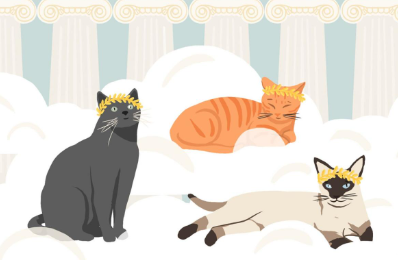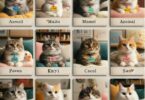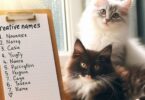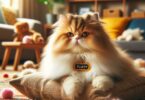In the mystical realms of ancient Celtic culture, cats held a significant and revered place. Their enigmatic presence, coupled with their prowess as hunters and guardians, made them symbols of protection, fertility, and mystery. The Celtic tradition, rich in mythology and folklore, attributed various divine aspects to cats, often personified through goddesses. These Celtic cat goddesses embodied the traits of the feline world and played pivotal roles in the spiritual and everyday lives of the Celts. This comprehensive article delves into the fascinating world of Celtic cat goddesses, exploring their names, attributes, and the stories that have transcended time to reach us today.

The Revered Place of Cats in Celtic Culture
Cats in Celtic mythology were not merely pets but revered creatures that symbolized various aspects of life and spirituality. They were considered protectors of the home, guardians of the underworld, and even companions of the gods. The Celts believed that cats possessed magical powers and were capable of warding off evil spirits. This belief is evident in the many tales and legends where cats play crucial roles in safeguarding the realm.
Famous Celtic Cat Goddess Names and Their Stories
- Ailuro: Derived from the Greek word “ailuros” meaning cat, Ailuro is often linked with goddesses who had feline attributes. This name symbolizes the watchful and protective nature of cats in Celtic lore.
- Cait: A common name, “Cait” directly translates to “cat” in Gaelic. It is associated with numerous myths where cats were seen as guardians of treasure and symbols of mystery and allure.
- Bastet: Though originally an Egyptian goddess, Bastet’s influence extended into Celtic mythology where she was revered as a protector deity with feline characteristics. She symbolizes home, fertility, and childbirth, resonating deeply with Celtic values.
- Macha: One of the triadic goddesses of Ireland, Macha is often depicted with cat-like agility and prowess. She represents war, fertility, and sovereignty, embodying the duality of nurturing and warrior aspects.
- Moggy: A playful yet revered name, “Moggy” signifies the domestic cat’s role in Celtic households. It symbolizes the balance between wild and tamed nature.
- Pangur: Inspired by the famous 9th-century poem “Pangur Bán,” this name evokes the wisdom and independence of the cat. It reflects the scholarly and mystical aspects of Celtic culture.
- Ceridwen: A powerful sorceress in Welsh mythology, Ceridwen is associated with transformation and wisdom. Her feline form emphasizes her ability to traverse different realms and her connection to magic.
- Freya: Although Norse in origin, Freya’s influence is seen in Celtic myths. She is associated with love, fertility, and magic, often accompanied by cats that symbolize her protective nature.
- Sìth: In Scottish Gaelic, “sìth” means fairy, but it also refers to cats with supernatural abilities. This name highlights the mystical and otherworldly aspects of Celtic feline deities.
- Li Ban: An Irish mermaid goddess, Li Ban’s story often intertwines with that of cats, representing transformation and the fluidity between realms.
Attributes and Symbols Associated with Celtic Cat Goddesses
Protection: Cats were seen as guardians against evil spirits and misfortune. Their keen senses and nocturnal nature made them perfect protectors in Celtic households.
Fertility: The nurturing aspect of cats was revered, with many goddesses embodying fertility and motherhood. Their ability to produce large litters symbolized abundance and prosperity.
Mystery and Magic: The elusive and independent nature of cats resonated with the Celtic view of the world. Cats were often seen as intermediaries between the human world and the spiritual realm, possessing hidden knowledge and magical abilities.
Wisdom and Learning: Cats were also symbols of wisdom and learning. Their observant nature and graceful movements were admired and often associated with scholarly pursuits and enlightenment.
The Role of Cats in Celtic Mythology and Society
Cats were not just mythical figures but integral parts of daily life in Celtic society. They were valued for their abilities to keep pests away, protecting grain stores and homes. This practical role soon intertwined with spiritual beliefs, elevating cats to a sacred status.
Detailed Stories and Legends of Celtic Cat Goddesses
Ailuro’s Vigil: In a small Celtic village, the legend of Ailuro tells of a cat goddess who protected the villagers from a malicious spirit. Each night, Ailuro would patrol the boundaries of the village, her eyes glowing in the dark, warding off any malevolent forces. The villagers offered her milk and fish, thanking her for her unwavering vigilance.
The Guardian Cats of Cait: The story of Cait revolves around a group of cats that guarded an ancient treasure hidden deep in the woods. These cats, with their sharp senses and agile movements, protected the treasure from thieves and invaders. The tale underscores the themes of loyalty and mystery, attributes deeply cherished in Celtic culture.
Bastet’s Blessing: Although Bastet is originally Egyptian, her tale found resonance in Celtic lands. She was believed to bless women with fertility and protect their homes. Celtic women often kept cat figurines as tokens of Bastet’s protection, merging their own beliefs with those of other cultures.
Macha’s Dual Nature: Macha, one of the most powerful goddesses, had the ability to shift into a cat. This transformation symbolized her connection to both the nurturing and warrior aspects of life. In one legend, she avenged her husband’s death by transforming into a fierce cat and defeating his enemies, showcasing her strength and protective nature.
Pangur’s Wisdom: The poem “Pangur Bán” speaks of a monk and his cat, drawing parallels between the cat’s hunting and the monk’s scholarly pursuits. Pangur, with his sharp focus and agility, becomes a symbol of wisdom and enlightenment, inspiring countless generations of Celtic scholars.
The Integration of Cat Symbolism in Celtic Art and Rituals
Celtic art is replete with depictions of cats, reflecting their revered status. Intricate designs featuring cats can be found on ancient jewelry, pottery, and stone carvings. These artistic representations often depict cats in protective stances, symbolizing their role as guardians.
In rituals, cats were honored through various ceremonies. For instance, during Samhain, the Celtic festival marking the end of the harvest season, cats were believed to protect against evil spirits. Offerings were made to cat goddesses to ensure protection and prosperity for the coming year.
Common Celtic Cat Goddess Names and Their Attributes
| Goddess Name | Attributes | Symbolism |
|---|---|---|
| Ailuro | Watchfulness, protection | Guardianship, vigilance |
| Cait | Mystery, allure | Treasure guarding, enigma |
| Bastet | Fertility, protection | Home, childbirth |
| Macha | War, fertility, sovereignty | Dual nature, transformation |
| Moggy | Domestic balance | Wild and tame nature |
| Pangur | Wisdom, independence | Scholarly pursuits, magic |
| Ceridwen | Transformation, wisdom | Magic, realm traversal |
| Freya | Love, fertility, magic | Protection, nurturing |
| Sìth | Supernatural abilities | Mysticism, otherworldly powers |
| Li Ban | Transformation, fluidity | Realm fluidity, mermaid aspects |
Modern Interpretations and Continuation of Celtic Cat Myths
The legacy of Celtic cat goddesses continues to inspire modern culture. From literature to films, the mystical and protective qualities of these deities are often explored and celebrated. Contemporary pagan practices also honor these goddesses, integrating ancient beliefs with modern spiritual practices.
Conclusion
The world of Celtic cat goddesses is a rich tapestry of mythology, spirituality, and everyday life. These goddesses symbolize protection, fertility, mystery, and wisdom, embodying the profound respect and admiration the Celts had for cats. Through detailed stories and legends, we see how these feline deities played crucial roles in shaping the spiritual and cultural landscape of Celtic society. Their legacy continues to inspire and captivate us, reminding us of the timeless bond between humans and these enigmatic creatures.
FAQs
Q1: What role did cats play in Celtic mythology?
A: In Celtic mythology, cats were seen as guardians, protectors, and symbols of mystery and magic. They were often associated with goddesses and played significant roles in various legends and tales.
Q2: Who is Macha in Celtic mythology?
A: Macha is one of the triadic goddesses of Ireland, known for her dual nature as a nurturer and a warrior. She is often depicted with cat-like agility and is associated with war, fertility, and sovereignty.
Q3: How are Celtic cat goddesses honored in modern practices?
A: Modern pagan practices continue to honor Celtic cat goddesses through rituals and ceremonies that integrate ancient beliefs with contemporary spiritual practices. These practices often involve offerings and symbolic representations of cats.






